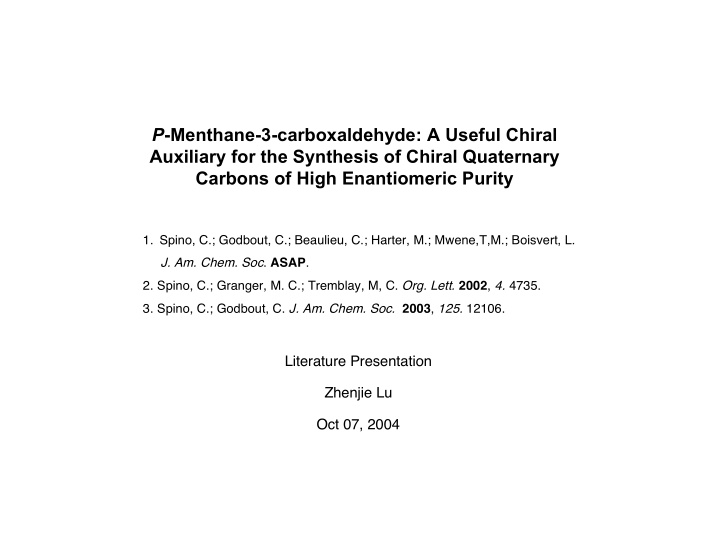



P -Menthane-3-carboxaldehyde: A Useful Chiral Auxiliary for the Synthesis of Chiral Quaternary Carbons of High Enantiomeric Purity 1. Spino, C.; Godbout, C.; Beaulieu, C.; Harter, M.; Mwene,T,M.; Boisvert, L. J. Am. Chem. Soc . ASAP . 2. Spino, C.; Granger, M. C.; Tremblay, M, C. Org. Lett. 2002 , 4. 4735. 3. Spino, C.; Godbout, C. J. Am. Chem. Soc. 2003 , 125. 12106. Literature Presentation Zhenjie Lu Oct 07, 2004
Attempts to Achieve Chiral Carbon Center Via enolate of defined geometry Via SN2 ’ displacement of an allylic leaving group
Menthone Chiral Auxiliary System Original menthone chiral auxiliary The displacement would not undergo if compound 8 is trisubstituted alkenes because of A 1,3 strain. Aldehyde as chiral auxiliary 1. Spino, C.; Beaulieu, C. J. Am. Chem. Soc. 1998 , 120 , 11832. 2. Spino, C.; Beaulieu, C. Angew. Chem. Int. Ed. 2000 , 39 , 1930.
Stereoselective Synthesis of β -Allylic Alcohols 12a-i β OH 13a-i α OH 10 Spino, C.; Granger, M. C.; Tremblay, M, C. Org. Lett. 2002 , 4. 4735.
Stereoselective Synthesis of α -Allylic Alcohols From the diastereomers. From acyl chloride with vinylsilane yield: 70-75%
Quaternary Chiral Center Formation by SN2’ Displacement Regioselectivity was strongly dependent on the nature R: CO- t -Bu of the leaving group and of the cuprate reagent. Cuprate: MeCu(CN)MgBr 22a:24 ratio: >99:1 Scheme 6. SN 2 ’ Displacement of pivalates 20 or 21 with cuprate reagents
i-Pr i-Pr R 1 R 1 R 2 R 2 Me Me R 3 PivO 20 22 i-Pr i-Pr R 1 R 1 R 3 R 2 Me Me R 2 PivO 21 23 Conclusions: 1. It ’ s General for primary or secondary alkylcuprates. 2. The same level of chirality transfer for 20 and 21 observed. 3. Bulky or less-reactive cuprates didn ’ t work. 4. Bulky substituent should preferably be part of the allylic alcohol. 5. There is no reaction when both R 1 and R 3 are bulky.
Conformational Biases of Pivalates 20 O O i -Pr i -Pr t -Bu O t -Bu O H H H H R 2 R 2 H H R 1 R 1 20A 20B R 3 Cu(CN)MgBr R 3 Cu(CN)MgBr i -Pr i -Pr H H H H R 2 R 2 H H R 3 R 1 R 3 R 1 22 never observed The controling elements in the transfer of chirality are: The anti-stereospecificity of the cuprate addition on allylic systems The conformational bias of the allylic ester toward conformations 20A provided by A 1,3 -strain (Adducts with a Z double bond, resulting from addition to conformer 20B , have never been observed.)
Cleavage of the Auxiliary X = H or OH Example 1 Example 2 Spino, C.; Beaulieu, C.; Lafreniere, J. J. Org. Chem. 2000 , 65. 7091.
Applications - Synthesis of an Analog of Taber’s Intermediate 31 (Antiulcer agent, isolated in 1988.) Taber, D. F.; Meagley, R. P.; Doren, D. J. J. Org . Chem. 1996 , 61 , 5723.
Applications - Synthesis of α , α -Dialkylated Amino Acid Route A: Route B: (Stereodivergent) Spino, C.; Godbout, C. J. Am. Chem. Soc. 2003 , 125. 12106.
Applications - Claisen Rearrangement i- Pr p- Tol Me Synthesis of (+)-Cuparenone OH Me 12i Antitumor effect Isolated in 1976
Applications - [2,3] Wittig Rearrangement
Conclusion - Versatile Methodologies i- Pr R 2 i- Pr R 2 R 1 R 3 Cu(CN)MgBr M Me R 1 OH R 3 R 2 R 1 ( �� ) Me 23 i- Pr R 1 O M i- Pr R 1 R 2 i- Pr Me R 3 Cu(CN)MgBr H R 1 R 2 R 3 Me Me R 2 OH ( �� ) 22 Me i -Pr O Claisen rearrangement (-)-menthone Swern i- Pr Wittig rearrangement R 1 (1kg : $72) R 1 R 3 R 2 Me Me 3 Si i- Pr 23 R 1 i- Pr R 2 O Me R 2 O Me Cl Et 3 BHLi i- Pr R 3 Cu(CN)MgBr R 1 Alternatively: Switch R 3 on cuprates to R 1 or R 2 Me R 2 OH Use (+)-menthone. ( �� )
Recommend
More recommend